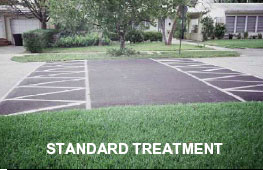Speed tables are flat-topped speed humps approximately 22 feet long, which is typically long enough for the entire wheelbase of a passenger car to rest on top. Their long flat fields, plus ramps that are more gently sloped than speed humps, give speed tables higher design speeds than humps and thus may be more appropriate for streets with higher ambient speeds. Brick or other textured materials improve the appearance of speed tables, draw attention to them, and may enhance safety and speed reduction.
The magnitude of reduction in speed is dependent of the spacing of speed tables between points that require drivers to slow. On average speed tables achieve an 18% reduction in speeds.

Advantages
- Smoother on large vehicles (such as fire trucks) than speed humps.
- Effective in reducing speeds, though not to the extent of speed humps.
Disadvantages
- Aesthetics of device.
- Increased noise.
- Textured materials, if used, can be expensive.
- Signs may be unwelcome by adjacent residents.
